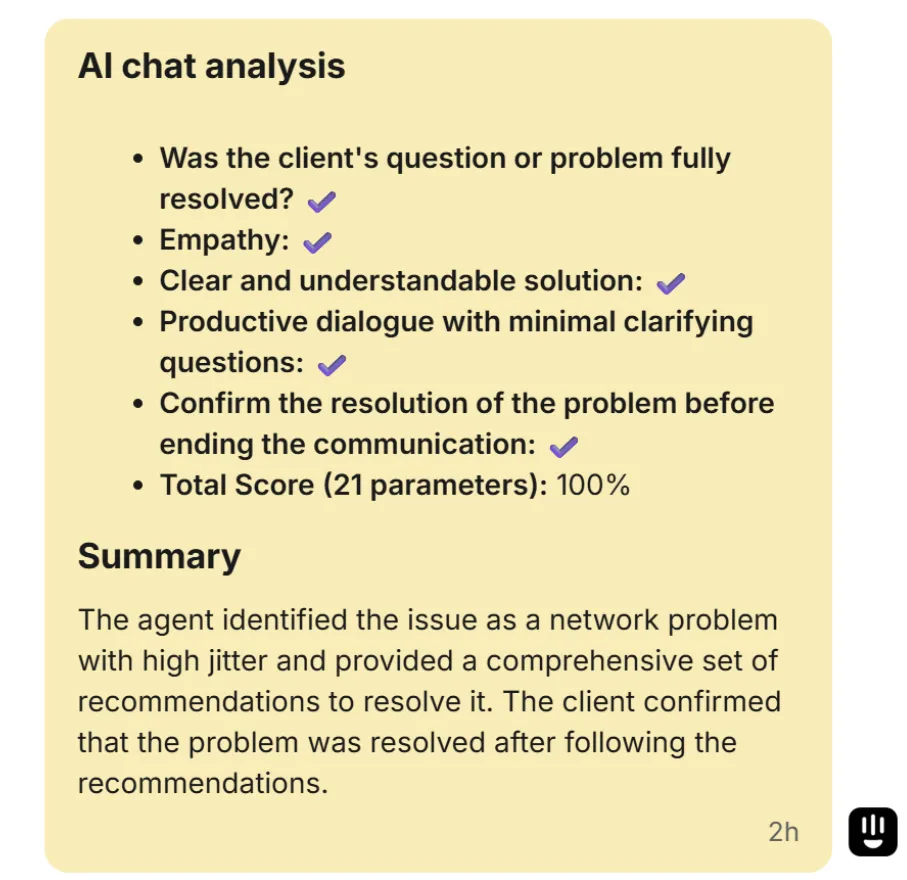Co to jest ticketing system i dlaczego Twoja firma go potrzebuje?


Wyobraź sobie: zwróciłeś się do firmy z problemem, menedżer obiecał przekazać zgłoszenie działowi technicznemu, ale po prostu o tym zapomniał. Najprawdopodobniej nie będziesz już współpracować z tak niezorganizowaną firmą. Zgodnie ze statystykami Zendesk, 61% klientów przejdzie do konkurencji po jednej nieudanej interakcji z firmą. A teraz policz w przybliżeniu, ilu potencjalnych nabywców straciłeś przez nieuwagę swoich menedżerów. Właśnie dlatego biznes potrzebuje systemu ticketowego. Pomaga on nie tracić zgłoszeń i na czas rozwiązywać problemy klientów.
System ticketowy (od ang. ticket — bilet) to oprogramowanie do automatycznego przetwarzania zgłoszeń klientów. Użytkownik może się skontaktować przez dowolny kanał komunikacji skonfigurowany przez firmę: telefon, email, czat na stronie lub media społecznościowe. Następnie jego pytanie przekształca się w ticket z unikalnym numerem, co upraszcza śledzenie zgłoszenia.
Główne etapy pracy z systemami ticketowymi w firmach:
Aby lepiej zrozumieć zalety systemu ticketowego, warto zacząć od wad tradycyjnej obsługi:
Jak widać, tradycyjna obsługa zajmuje dużo czasu i wcale nie jest zabezpieczona przed „czynnikiem ludzkim". System ticketowy rozwiązuje wspomniane problemy i poprawia efektywność pracy firmy:
Podłącz wirtualną centralę telefoniczną w jeden dzień roboczy i odbieraj połączenia w dowolnym miejscu na świecie





Wykorzystanie systemów ticketowych pozwala zautomatyzować część rutynowych procesów. Na przykład ticketing system może automatycznie powiadamiać użytkowników o zmianie statusu ich zgłoszeń. Menedżer nie musi stale informować klientów o postępie prac, martwić się, że o kimś zapomniał. A użytkownik zawsze na czas otrzymuje informacje o swoim zgłoszeniu i widzi, że ktoś nad nim pracuje.
Można również zautomatyzować dystrybucję ticketów między członkami zespołu. Jedną z opcji jest automatyczne przekazanie zgłoszenia do pracownika, który specjalizuje się w problemie klienta. Na przykład, jeśli klient potrzebuje konsultacji w sprawie przygotowania dokumentów, zgłoszenie automatycznie trafia do specjalisty działu dokumentacji. Można również skonfigurować dystrybucję zgłoszeń w zależności od obciążenia menedżerów. Kto ma mniej zadań, do tego „trafi” nowe zgłoszenie.
Dział obsługi klienta Ringostat wykorzystuje bota AI do automatycznego przetwarzania prostych zgłoszeń. To zmniejsza obciążenie zespołu, pozwalając poświęcić więcej uwagi innym zgłoszeniom. Jeśli pytanie wykracza poza możliwości bota, przekazuje on sprawę do działu wsparcia. Dzięki temu żadne zgłoszenie nie zostanie utracone.
Po integracji z telefonią IP zgłoszenia klientów otrzymane podczas rozmowy telefonicznej automatycznie trafią do systemu ticketowego. Ringostat oferuje również wygodną aplikację do obsługi połączeń telefonicznych i wiadomości z komunikatorów oraz czatu na stronie w jednym interfejsie. Przy korzystaniu z Ringostat Smart Phone wszystkie zgłoszenia będą wygodnie przekazywane do systemu.
Integracja z CRM pozwala menedżerowi od razu zobaczyć dane o kliencie i pełny obraz interakcji z nim. Na przykład historię zgłoszeń. Jeśli podłączono również Ringostat AI, w CRM będą przechowywane kluczowe momenty poprzednich komunikacji. To pomaga poprawić jakość obsługi, ponieważ specjalista będzie już miał wyobrażenie o kliencie i jego problemach. Również dzięki scentralizowanemu przechowywaniu informacji można łatwo przekazać zgłoszenie innemu specjaliście. Szybko włączy się on w obsługę ticketu, ponieważ będzie miał całą historię interakcji z użytkownikiem.
Dzięki systemowi ticketowemu kierownik ma pełny obraz interakcji specjalistów z klientami. To pozwala oceniać obciążenie, na czas zauważać odchylenia od terminów i regulaminów firmy itd. Na przykład, jeśli w systemie jest dużo ticketów i pracownicy są przeciążeni, to sygnał, że pora rozszerzyć zespół. Rozwiązywanie przez pracownika zgłoszeń w dwa dni zamiast jednego to możliwy znak, że brakuje mu wiedzy czy doświadczenia. Oznacza to, że trzeba zorganizować dodatkowe szkolenie.
Analityka językowa z AI od Ringostat pomaga dowiedzieć się, czy klienci zwracają się nie pierwszy raz z tym samym problemem. Na przykład można skonfigurować, aby rozwiązanie reagowało na słowa kluczowe: „nie działa”, „ponownie się zwracam”, „problem nie został rozwiązany” itd. Kierownik będzie mógł przejrzeć te zgłoszenia, aby jak najszybciej znaleźć przyczynę problemu. Jeśli na czas nie usunie się niedoskonałości procesu rozwiązywania zgłoszeń czy niekompetencji pracowników, można stracić klientów, a wraz z nimi dochód.
Małym firmom może się wydawać, że otrzymują mało zgłoszeń i nie potrzebują systemu ticketowego. Ale pominięte zgłoszenie czy brak historii komunikacji z klientem może doprowadzić do jego utraty. Na przykład menedżer komunikował się z użytkownikiem w komunikatorze, do którego miał dostęp tylko on. Nagle u pracownika pojawiły się okoliczności, przez które pewien czas nie pracował i, odpowiednio, nie logował się na konto służbowe.
Rezultat? Użytkownik „puka do zamkniętych drzwi” i nie otrzymuje odpowiedzi. Możliwe, że od razu idzie do bardziej zorganizowanej konkurencji. Albo najpierw próbuje skontaktować się z innymi specjalistami, którzy nic o nim nie wiedzą ani o jego problemie. Klient musi odpowiadać na te same pytania i jeszcze czekać, aż wreszcie rozwiąże się jego problem. Prawdopodobnie w przyszłości ten użytkownik przejdzie do konkurencji.
Duże firmy, przeciwnie, mają wiele działów, pracowników i zgłoszeń. Jeśli nie ma scentralizowanego systemu, zgłoszenia gubią się między różnymi kanałami komunikacji. Na przykład klient napisał na pocztę, zadzwonił do działu sprzedaży, a potem jeszcze zostawił zgłoszenie na stronie. W rezultacie każdy dział osobno opracowuje jego pytanie. Gdy użytkownika będą trzy razy pytać o to samo, obniży to zaufanie do firmy.
Optymalizacja wydajności + pełna kontrola = więcej transakcji

Wybór właściwego systemu ticketowego to inwestycja w przyszłość Twojej obsługi klienta. Im mniej problemów i pytań pojawi się podczas interakcji z systemem, tym efektywniej będzie pracował zespół. Oto kluczowe kryteria, które warto wziąć pod uwagę przy wyborze systemu ticketowego.
System będzie miał dostęp do poufnych informacji klientów i firmy. Ich utrata doprowadzi zarówno do strat finansowych, jak i reputacyjnych. Nikt nie będzie współpracować z biznesem, który nie dba o zachowanie wrażliwych danych. Dlatego krytycznie ważne jest sprawdzenie następujących kwestii:
Jeśli twórca ticketing system posiada certyfikat ISO/IEC 27001:2022, to „zielona flaga”, która oznacza, że biznes jest nastawiony na maksymalną ochronę danych klientów. Tak jak platforma telefonii IP Ringostat, która niedawno otrzymała międzynarodowy standard bezpieczeństwa informacji najnowszej wersji.
Biznes stale pracuje nad rozszerzeniem wpływu na rynku. A wraz ze wzrostem liczby zamówień rośnie też liczba ticketów, pojawia się potrzeba zatrudnienia nowych specjalistów do zespołu. Dlatego od razu wybierz system ticketowy, który można łatwo skalować w zależności od potrzeb biznesu. W przeciwnym razie z czasem będziesz musiał kupić nowy.
System ticketowy powinien być intuicyjnie zrozumiały, ponieważ to pomocnik dla pracowników, a nie przeszkoda na drodze do realizacji zgłoszenia klienta. Nowi członkowie zespołu powinni móc szybko rozpocząć pracę, a nie tracić dużo czasu na naukę systemu.
Każdy ticket powinien od razu wyświetlać się z ważnymi informacjami: poziom priorytetu, aktualny status, wykonawca i termin realizacji. Taka wizualizacja pomaga efektywnie zarządzać zgłoszeniami i równomiernie rozdzielać obciążenie między członkami zespołu.
Inną ważną cechą jest minimalna liczba działań do wykonania typowych operacji. Podstawowe funkcje — odpowiedź na zgłoszenie, zmiana parametrów ticketu, zastosowanie gotowych szablonów — powinny być dostępne w jeden-dwa kliknięcia. To nie tylko oszczędza czas, ale także zmniejsza prawdopodobieństwo błędów przy pracy z dużymi wolumenami zgłoszeń.
Wersja mobilna jest krytycznie ważna dla firm z całodobowym wsparciem. Menedżerowie mogą operatywnie reagować na krytyczne sytuacje, nawet pracując zdalnie.
Czasami pracownik może odejść na pocztę czy magazyn, do innego biura, na spotkanie. Mając system ticketowy dostosowany do telefonu komórkowego, zawsze będzie w kontakcie.
Jakkolwiek niezawodny i wygodny nie byłby system, mogą pojawić się trudności podczas jego użytkowania. Albo po prostu pojawi się konieczność wprowadzenia zmian w konfiguracji, co będzie wymagało zaangażowania specjalistów twórcy systemu ticketowego. Jeśli będziesz długo czekać na odpowiedź działu technicznego, spowolni to pracę firmy. Szczególnie gdy przez problem nie można przetwarzać zgłoszeń.
Dlatego wybieraj twórcę systemu ticketowego, który gwarantuje szybką odpowiedź wsparcia technicznego. Na przykład klienci telefonii IP Ringostat otrzymują odpowiedź w ciągu dwóch minut.
Niektórzy kierownicy popełniają rozpowszechnione błędy, które obniżą motywację pracowników i produktywność pracy z systemem ticketowym. Przygotowaliśmy rekomendacje, które pomogą wam tego uniknąć.
Przyszłość systemów ticketowych jest ściśle związana z rozwojem sztucznej inteligencji. Zgodnie z badaniem Gartner, już 80% firm wykorzystuje AI do poprawy obsługi klienta. Sztuczny asystent szybko się uczy, dostosowuje do specyfiki biznesu i stale się rozwija. Dział obsługi klienta Ringostat również wykorzystuje AI do analizy jakości obsługi klientów.

Pracownik na końcu rozmowy otrzymuje wynik od sztucznej inteligencji, który pomaga zrozumieć, jakie umiejętności warto poprawić. A kierownik ma dodatkowe narzędzie do kontroli jakości pracy z klientami.
Każde zgłoszenie klienta otrzymuje unikalny numer, co pozwala systemowo śledzić jego status: od wpłynięcia do pełnego rozwiązania.
System pozwala automatycznie tworzyć tickety, rozdzielać je między pracownikami, wysyłać powiadomienia klientom, generować raporty i analitykę na podstawie zebranych danych.
System upraszcza komunikację między klientem a działem technicznym, minimalizuje czynnik ludzki i zapewnia kontrolę nad dotrzymywaniem terminów i jakością odpowiedzi.
Nauczymy Ringostat AI Supervisor wykonywać zadania właśnie Twojego biznesu
